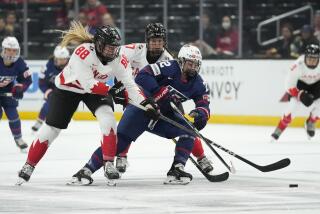Avalanche of Hope : Latest Hockey Team in Denver Trying to Put Failures of Past Behind
DENVER â The smell of fresh popcorn and a Thank-God-Itâs-Friday giddiness create a festive mood at McNichols Arena. Most fans strolling along the main concourse have gotten a jump on the weekend by changing from office outfits to casual clothes, and a remarkable number are wearing shirts, jackets or caps with their favorite teamâs logo.
Dots of orange appear here and there, signs of allegiance to the Denver Broncos. The dominant colors are the purple, black and white of the Colorado Rockies, but some fans wear the blue , white and red of the Colorado Rockies.
Before the first altitude-aided home run sailed out of a major-league baseball stadium in Denver, there was Rocky Hockey. Transplanted from Kansas City to the Mile High City in 1976, the original Rockies were a monument to ineptitude, too awful to be lovable except to a faithful few. They wobbled through six seasons and three owners before they were sold and moved to New Jersey, leaving behind only a memorable logo--a blue âCâ encircling a yellow sun in front of a jagged mountain--and a fan club that refused to die.
The Rockies were the most notable in a series of Denver hockey experiments that began in 1950 with the Falcons of the U.S. Hockey League. Clubs sprang up every few years but few lasted; the Spurs of the World Hockey Assn. went on the road in January 1976 and never came back.
But the NHL came back this season after Comsat--a multimedia conglomerate that also owns the NBAâs Denver Nuggets--purchased the Quebec Nordiques for $75 million and moved them to Colorado. The Avalanche is Denverâs eighth pro hockey club since the Falcons, but itâs the first with the money, business sense and marketing savvy to take root and flourish.
âI guarantee that this team is going to do well, and itâs not going to be just one of those morning-glory franchises that do well for three or four years and then drop off,â said Don Cherry, the colorful coach who was a local icon and lured an average of nearly 10,000 fans to Rockiesâ games in 1979-80, his lone season behind their bench.
âWhen I was there, everything was against that hockey club. They had an owner [Arthur Imperatore] who said, âIâm only going to keep the team here two years and then move it to New Jersey,â and then they had a disaster of a general manager, Ray Miron, and a bad lease. They got no revenues from parking, concessions or advertising.
âBut the fans who came were the most enthusiastic 10,000 hockey fans Iâve ever seen. My last game, there were 12,500 people in a bad snowstorm. This team, theyâve got everything going for them--a great lease, a good team and good owners. I wish I had part of the club. Itâs a mint to print money.â
Original Rockie owner James Vickers was an oilman who went bust when the market failed and couldnât get financial aid from the city to keep the club going.
In 1978, Vickers sold the club to Imperatore, a New Jersey trucking company executive who announced he would move the Rockies to his home state when a new arena was built. Alienated again, fans stayed away. Three years later, before he could move them, Imperatore sold them to Peter Gilbert, a cable-TV magnate from Buffalo. Gilbert, citing overwhelming losses, sold the club in 1982 to John McMullen, who moved them to New Jersey and renamed them the Devils.
Comsat has the resources to build an arena, planned for the 1998-99 season, and the foresight to avoid pitfalls that doomed the Rockies.
Unlike the Rockies, the Avalanche gets a cut of parking and concession revenues at city-owned McNichols Arena. In addition, the Avalanche shares its business and marketing operations with the Nuggets, which saves money and allows it to capitalize on the Nuggetsâ knowledge of the area.
âThe Avalanche will succeed, basically for one big, big reason. Itâs called the golden rules--whoever has the gold rules,â said Art Caldwell, a local hockey historian and longtime member of the Colorado Blueliners, a fan club that has supported Denverâs various hockey ventures.
âComsat has billions and billions of dollars, and when they speak, everyone listens, especially politicians,â said Caldwell, the Avalancheâs first season-ticket buyer. âDenver will bend over backward for this. If the [city] administration gave this kind of support or anywhere near it to Jack Vickers, the Colorado Rockies would still be here.â
Within six weeks of its move, before it had a name or a logo, the Avalanche had sold 12,000 season tickets. It might have sold all 16,061 seats, but club executives decided to leave the remaining tickets for single-game purchase. Four games have been sellouts and, on three other occasions, the crowd fell short by fewer than 700. Prices range from $100 for the row of seats that rings the ice surface to a low of $10, and the average of $30.61 ranks 20th among the NHLâs 26 teams. Forty percent were sold to corporations.
Keeping prices relatively low was a smart move. The previous hockey tenant at McNichols was the Denver Grizzlies of the International Hockey League, who averaged 12,094 fans last season with a peak price of $13. Charging premium NHL prices might have driven those fans away, but the Avalanche instead courted and won many of them.
âWe got spoiled with the Grizzlies because their ticket prices were so low. They were a lot of fun, but a lot of people were rooting for fights,â said Tracy Tiedman of Denver, who has Avalanche season tickets with her husband, Paul. âThe quality of play in the NHL is much better. . . . I think the Avalanche will succeed. Denver loves professional sports, as weâve seen with the [baseball] Rockies.â
Merrick Makowka of Denver had season tickets to the NHL Rockies, but the blue jersey he wears is a replica, not an original. He also followed the Grizzlies but doesnât miss them.
âWhen I heard the Avalanche was coming, I said, âFinally, something good,â â he said. âI think this can work as long as itâs promoted right.â
The Avalanche entertains fans with trivia contests, fireworks and a pulsating logo--a red A surrounded by a swirl of white that resembles snow coursing down a mountain. Most fans know the game and cheer spontaneously and enthusiastically. One fan makes himself part of the show by belting lusty Tarzan yells during lulls.
âThe fans have been tremendous. The games sell out and theyâre really excited,â Colorado center Joe Sakic said. âItâs a great building to play in and a great city to play in.â
It helps too that fans arenât being subjected to the missteps of an expansion team. Last season, as the Nordiques, the Avalanche led the NHL in goals and had the best record in the Eastern Conference. Center Peter Forsberg was the rookie of the year and Coach Marc Crawford was the coach of the year. This season, the Avalanche is leading the Pacific Division and has the best record in the Western Conference.
âWe have a young team thatâs a contender and we expect to win,â said General Manager Pierre Lacroix, who made the move from Quebec. âAnd it helps that the owners spend a little more money to get a quality team.â
Caldwellâs only complaint is the Avalanche decided to break with the past and not display any Rockie or Nordique artifacts at McNichols. âIâd love to see a Rockie banner,â he said. âThis logo, Iâm still getting used to it.â
More to Read
Go beyond the scoreboard
Get the latest on L.A.'s teams in the daily Sports Report newsletter.
You may occasionally receive promotional content from the Los Angeles Times.







